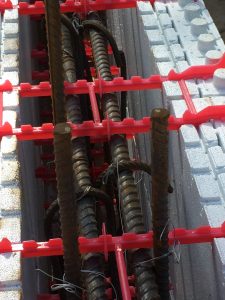The importance of a thermal break
The walls in the photo are composed of 6″ of concrete and rebar surrounded on both sides by 4.25″ of foam, for a total of 14 1/2″ thick walls. Basement walls are 8″ thick concrete, with the same foam, totaling 16 1/2″ thick. This provides an R-38 wall value, with zero “thermal bridging”.
Thermal bridging is a very important concept in efficient home construction. When poor insulating materials, i.e.- a wood stud, are in contact with the homes interior and exterior, a thermal bridge is created. The wood studs in the wall transfer the cold exterior to the interior, there is no “thermal break” to stop the cold transfer. In ICF construction (insulated concrete forms), the foam is continuous on the homes exterior and interior, no thermal bridging occurs.
In homes with in-floor radiant heat, it is important to block the hot concrete slab from coming into contact with the cold exterior with a thermal break. This home uses a specially engineered product called compact foam to block heat transfer to the outdoors. This foam has the structural rigidity of wood and the insulting value of foam.

ICF construction stops thermal bridging and creates an extremely solid structure
